| View previous topic :: View next topic |
| Author |
Message |
Peter Farquhar
Site Admin

Joined: 14 May 2011
Posts: 51
Location: Virginia



|
 Posted: Aug 22, 2012 19:58 Post subject: Re: About cyclic twinning - (5) Posted: Aug 22, 2012 19:58 Post subject: Re: About cyclic twinning - (5) |
|
|
The rutile sixling from Atglen, Pennsylvania shown below looks almost identical to the purple 3-D drawing that Pete Richards posted earlier.
Peter Farquhar
Claremont, California
USA
| Description: |
Rutile
Atglen, Lancaster County, Pennsylvania, USA
2.1 x 2.1 x1.5 cm
A complete rutile sixling from Pennsylvania (PF-3147). |
|
| Viewed: |
35977 Time(s) |
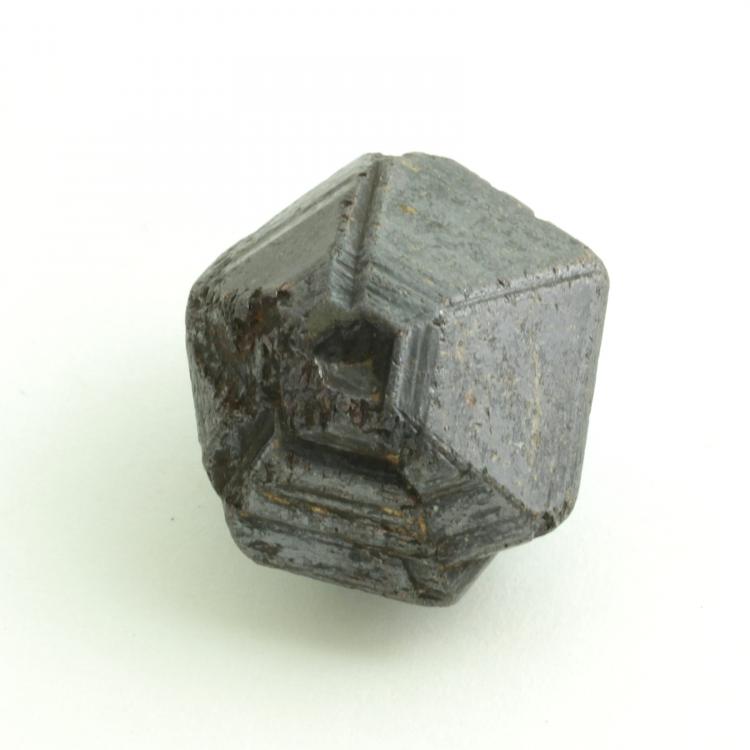
|
|
|
| Back to top |
|
 |
Pete Richards
Site Admin
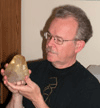
Joined: 29 Dec 2008
Posts: 828
Location: Northeast Ohio



|
 Posted: Aug 22, 2012 20:57 Post subject: Re: About cyclic twinning - (5) Posted: Aug 22, 2012 20:57 Post subject: Re: About cyclic twinning - (5) |
|
|
| RutileFox wrote: | | The rutile sixling from Atglen, Pennsylvania shown below looks almost identical to the purple 3-D drawing that Pete Richards posted earlier. |
Wow! That's amazing! I've never seen a real rutile twin that was so close to the theoretical morphology. Thanks for posting it. (I covet it, but will have to settle for the image.)
_________________
Collecting and studying crystals with interesting habits, twinning, and epitaxy |
|
| Back to top |
|
 |
gemlover

Joined: 31 Dec 2008
Posts: 211
Location: Easley, SC



|
 Posted: Aug 22, 2012 23:35 Post subject: Re: About cyclic twinning - (5) Posted: Aug 22, 2012 23:35 Post subject: Re: About cyclic twinning - (5) |
|
|
Great and beautiful specimen. And from Atglen, I lived in both Chester and Lancaster counties in that area.
John
_________________
John
John Atwell Rasmussen, Ph.D.. AJP
Geologist and Gemologist |
|
| Back to top |
|
 |
Peter Farquhar
Site Admin

Joined: 14 May 2011
Posts: 51
Location: Virginia



|
 Posted: Aug 25, 2012 19:14 Post subject: Re: About cyclic twinning - (5) Posted: Aug 25, 2012 19:14 Post subject: Re: About cyclic twinning - (5) |
|
|
Another perspective on cyclic twinning in rutiles:
The photographic plate below is from Louis Pope Gratacap’s famous 1912 book, "A Popular Guide to Minerals." The black-and-white plate nicely illustrates different forms of cyclic twinning with three Pennsylvania rutile specimens. Gratacap selected these rutiles from the Clarence S. Bement collection in the American Museum of Natural History, where Gratacap served as the Curator of Mineralogy in the early 1900s.
In 1907, Gratacap used this same plate for another purpose in a short article he published on mineral photography in the "American Annual of Photography 1908." Gratacap was experimenting at the time with different lighting techniques and camera lens, and chose these rutile specimens to illustrate the many challenges in photographing cyclic twins. But little has changed more than a century later. Wendell Wilson recently commented that rutiles “are one of those minerals that are very difficult to photograph, and the worst of the lot are the cyclic twins …” (Axis, 2005).
With these warnings in mind, I tried to recapture in the 2012 color image shown below the same Parkesburg rutile specimen figured on the right side of Gratacap’s 1907 plate. A side-by-side comparison of these two images reveals the complex challenges in portraying the “geniculated oscillations” that Gratacap wrestled with over a century ago.
Peter Farquhar
Claremont, California
USA
| Description: |
Rutiles
Parkesburg, Chester County, Pennsylvania USA
L. P. Gratacap photo of three Clarence S. Bement rutile specimens from the American Museum of Natural History in New York City (1907) |
|
| Viewed: |
35736 Time(s) |
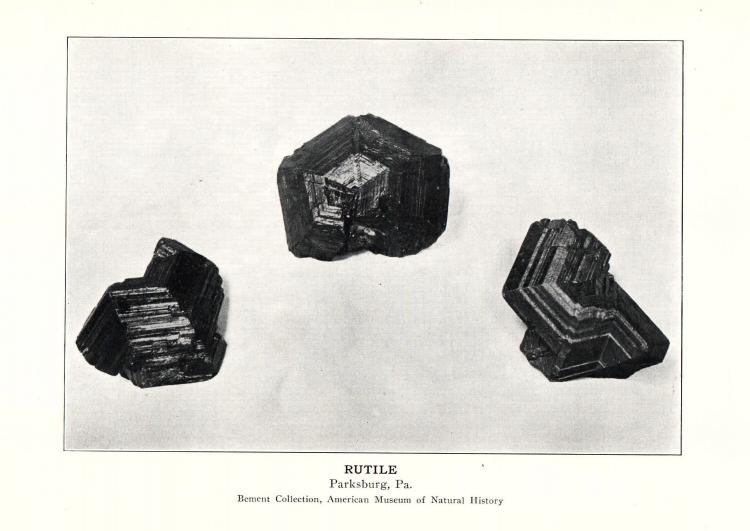
|
| Description: |
Rutile
Parkesburg, Chester County, Pennsylvania USA
5.0 x 3.4 x 2.8 cm
Comparison of the same cyclic twinned rutile specimen (PF-1781 ) as photographed in 1907 vs. 2012. |
|
| Viewed: |
35732 Time(s) |
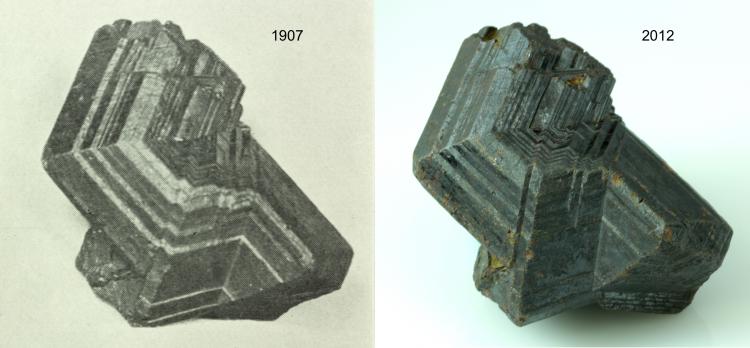
|
|
|
| Back to top |
|
 |
John Jaszczak

Joined: 05 Oct 2010
Posts: 300
Location: Hancock, MI



|
 Posted: Aug 27, 2012 17:57 Post subject: Re: About cyclic twinning - (5) Posted: Aug 27, 2012 17:57 Post subject: Re: About cyclic twinning - (5) |
|
|
| Nicely done!
|
|
| Back to top |
|
 |
Peter Farquhar
Site Admin

Joined: 14 May 2011
Posts: 51
Location: Virginia



|
 Posted: Sep 18, 2012 17:24 Post subject: Re: About cyclic twinning - (5) Posted: Sep 18, 2012 17:24 Post subject: Re: About cyclic twinning - (5) |
|
|
| Tracy wrote: | I recently saw an image of a rutile specimen described as a cyclic twin, however the specimen wasn't round - rather, it looked like a series of steps or a "w" with a few extra bends (vvv-like). Was this an accurate description? I would expect a cyclic twin to be cyclic (= ring-shaped), but was wondering what are the criteria?
... The specimen I saw has six distinct faces, appears to be planar or nearly so, and originates from Diamantina.
- Tracy |
After a lengthy search, I found a specimen that fits Tracy’s description at the beginning of this thread. With the kind permission of the photographer, I’m able to post images of this rutile specimen from Diamantina, Brazil on FMF. (Tracy, is this the image you saw?)
I’m not sure we answered Tracy’s original question correctly, so I’d like to reopen the discussion on this thread using this image.
The question for the Forum is how would you describe the twinning exhibited by this rutile specimen below? In particular, does it meet the criteria discussed for a cyclic twin?
I’d describe this specimen as a group of intergrown V-twins of rutile, but not a cyclic twinned rutile. One reason is that this rutile does not appear to exhibit repeated twinning. I’d really like to know what others think about this interesting puzzle.
Peter Farquhar
Claremont, California
USA
| Description: |
Rutile (front view)
Diamantina, Brazil
1.5 x 0.5 x 0.4 cm
Photo by Heliodor; used with permission. |
|
| Viewed: |
35577 Time(s) |
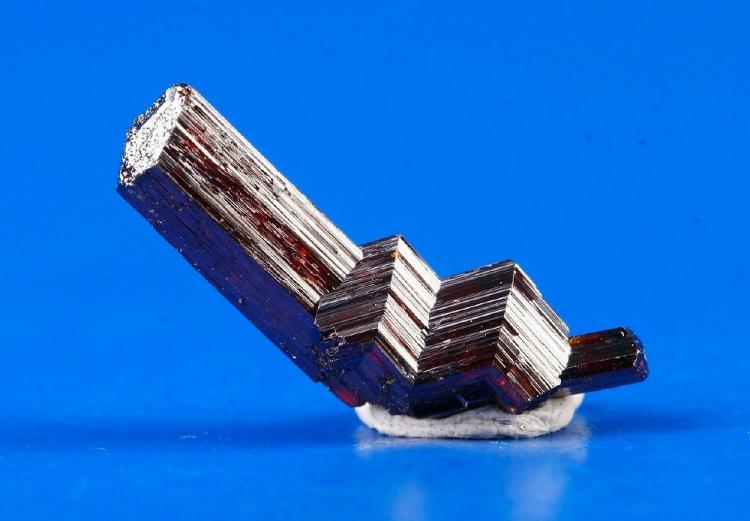
|
| Description: |
Rutile (rear view)
Diamantina, Brazil
1.5 x 0.5 x 0.4 cm
Photo by Heliodor; used with permission. |
|
| Viewed: |
35326 Time(s) |
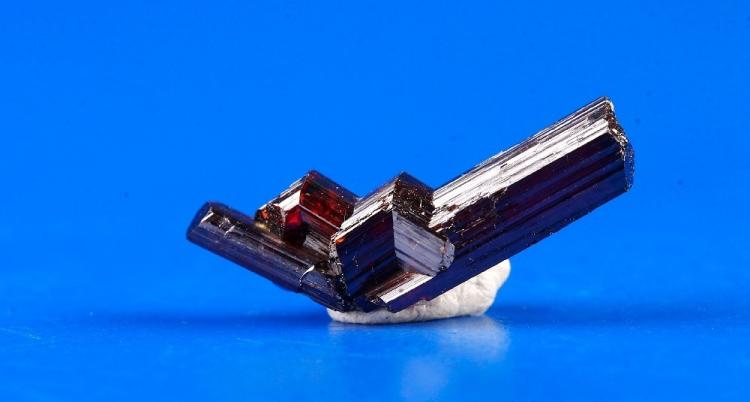
|
|
|
| Back to top |
|
 |
Tracy

Joined: 15 Sep 2006
Posts: 551
Location: Toronto



|
 Posted: Sep 19, 2012 06:47 Post subject: Re: About cyclic twinning - (5) Posted: Sep 19, 2012 06:47 Post subject: Re: About cyclic twinning - (5) |
|
|
| RutileFox wrote: | | Tracy wrote: | I recently saw an image of a rutile specimen described as a cyclic twin, however the specimen wasn't round - rather, it looked like a series of steps or a "w" with a few extra bends (vvv-like). Was this an accurate description? I would expect a cyclic twin to be cyclic (= ring-shaped), but was wondering what are the criteria?
... The specimen I saw has six distinct faces, appears to be planar or nearly so, and originates from Diamantina.
- Tracy |
After a lengthy search, I found a specimen that fits Tracy’s description at the beginning of this thread. With the kind permission of the photographer, I’m able to post images of this rutile specimen from Diamantina, Brazil on FMF. (Tracy, is this the image you saw?)
|
Peter, that's the one! - you beat me by a day, I was about to try my hand at photographing it since it's now mine. :-)
Looking at all the illustrations provided, and reading through the comments, I still don't have a clear answer. And now Peter has added photos. Is this specimen a cyclic twin?
(I'm surprised to read that rutile doesn't undergo cyclic twinning, this seems inconsistent with other posts and images)
- Tracy
_________________
"Wisdom begins in wonder" - Socrates |
|
| Back to top |
|
 |
Tracy

Joined: 15 Sep 2006
Posts: 551
Location: Toronto



|
 Posted: Sep 20, 2012 06:54 Post subject: Re: About cyclic twinning - (5) Posted: Sep 20, 2012 06:54 Post subject: Re: About cyclic twinning - (5) |
|
|
Um...so that's one vote for yes, and one vote for no? I'm really confused.
- Tracy
_________________
"Wisdom begins in wonder" - Socrates |
|
| Back to top |
|
 |
Pete Richards
Site Admin

Joined: 29 Dec 2008
Posts: 828
Location: Northeast Ohio



|
 Posted: Sep 20, 2012 10:37 Post subject: Re: About cyclic twinning - (5) Posted: Sep 20, 2012 10:37 Post subject: Re: About cyclic twinning - (5) |
|
|
| RutileFox wrote: | | The question for the Forum is how would you describe the twinning exhibited by this rutile specimen below? In particular, does it meet the criteria discussed for a cyclic twin? |
A very interesting specimen!
I would not call it a cyclic twin, because in my opinion a zig-zag twin shows repeated but not cyclic twinning. But this crystal seems to hide some other secrets, revealed by the second photo. It appears to show that this is actually at least three and probably four separate crystals, two (or maybe three) of them v-twins, as Peter said. These individual crystals/twins have grown into each other as they got larger.
If this is correct, how did they manage to assume parallel orientations?!!! I like to think that these kinds of twins - and many sagenite arrays - are actually examples of epitaxy (probably on ilmenite or hematite) in which the host weathered away, perhaps before the rutile stopped growing. I have examples of rutiile pseudomorphs after ilmenite(?) from Mont Saint-Hilaire which are almost perfect hexagonal plates, but with microtextures that demonstrate that they are aggregates of oriented crystals. SEM/EDS shows that they contain only titanium and oxygen - no iron!
| Description: |
Rutile (sagenite)
Erdgestollen Obergesteln, Goms, Wallis, Switzerland
3 cm group
Naturhistorisches Museum Basel specimen, Erich Offermann photograph |
|
| Viewed: |
35205 Time(s) |
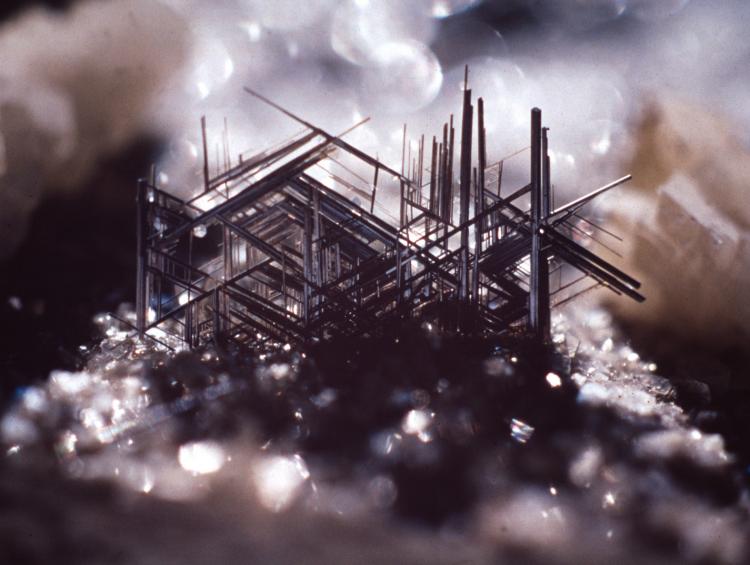
|
| Description: |
Rutile (sagenite)
Lamme, Ernen, Binntal, Wallis, Switzerland
Field of view 28 mm tall
Naturhistorisches Museum Basel specimen, Erich Offermann photograph |
|
| Viewed: |
35198 Time(s) |
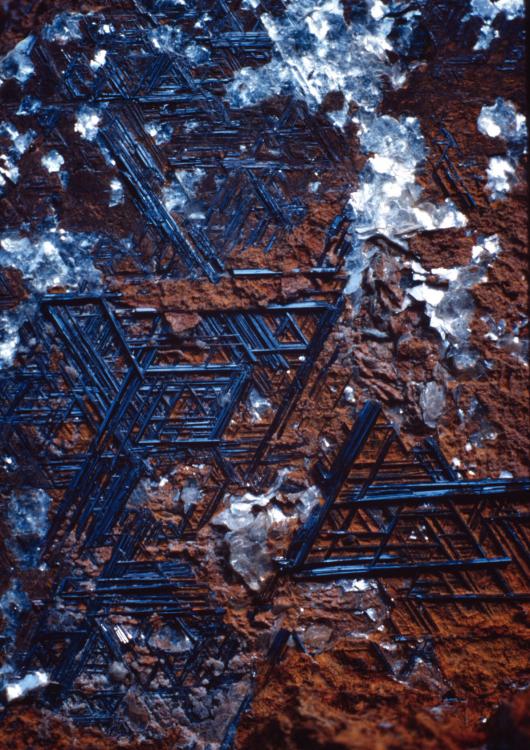
|
| Description: |
Rutile after ilmenite(?)
Poudrette Quarry, Mont Saint-Hilaire, Quebec, Canada
0.5 mm crystal |
|
| Viewed: |
35162 Time(s) |
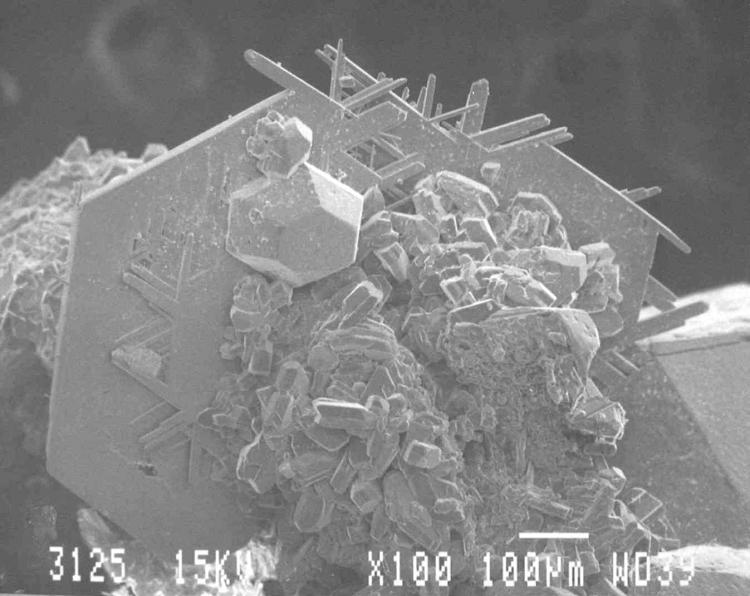
|
| Description: |
Rutile after ilmenite(?)
Poudrette Quarry, Mont Saint-Hilaire, Quebec, Canada |
|
| Viewed: |
35176 Time(s) |
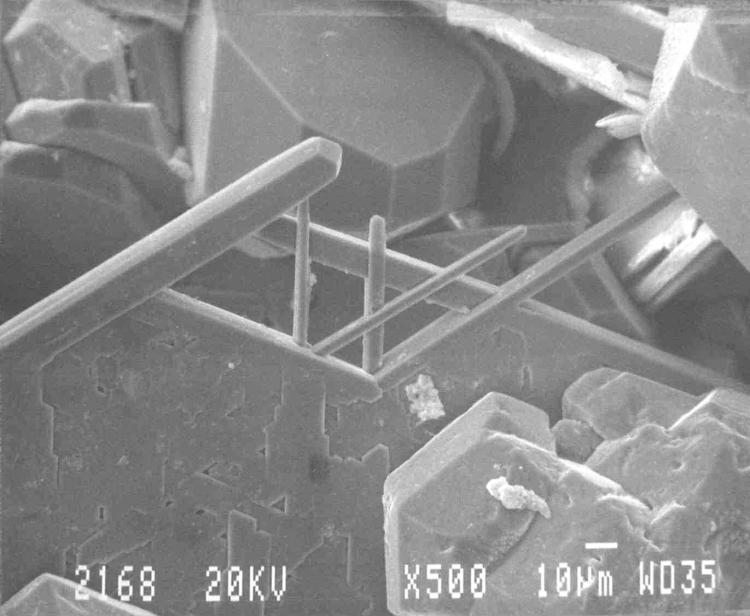
|
_________________
Collecting and studying crystals with interesting habits, twinning, and epitaxy |
|
| Back to top |
|
 |
Tracy

Joined: 15 Sep 2006
Posts: 551
Location: Toronto



|
 Posted: Sep 20, 2012 11:25 Post subject: Re: About cyclic twinning - (5) Posted: Sep 20, 2012 11:25 Post subject: Re: About cyclic twinning - (5) |
|
|
Would other photo angles be helpful? I should have time this weekend.
Thanks Pete and Peter! The suggestion of intergrown v-twins makes sense to me.
[Puzzles make me happy. :-)]
- Tracy
_________________
"Wisdom begins in wonder" - Socrates |
|
| Back to top |
|
 |
Peter Farquhar
Site Admin

Joined: 14 May 2011
Posts: 51
Location: Virginia



|
 Posted: Sep 23, 2012 13:32 Post subject: Re: About cyclic twinning - (5) Posted: Sep 23, 2012 13:32 Post subject: Re: About cyclic twinning - (5) |
|
|
Thanks Pete for explaining that parallel orientations of rutile V-twins may be the result of epitaxy where the host has weathered away. This solves one mystery for me about twinning. Now I have another question.
In general, what are the criteria that distinguish between crystals that are merely intergrown versus ones that are twinned? How does this definition determine whether three or more crystals are repeatedly twinned versus just being intergrown?
Below is another rutile from Diamantina similar to the one Tracy has. I'll ignore for now the one small V-twin stacked on top of two larger V-twins. My question is about the two larger V-twins -- are they simply intergrown (V-V), or are they repeated twins (W)?
Based upon the boundary where they contact each another, it looks like the two larger V twins are simply intergrown, but not repeatedly twinned. I'd like some help sorting this out. Thanks.
Peter Farquhar
Claremont, California
USA
| Description: |
Rutile
Diamantina, Brazil
2.8 x 2.1 x 0.6 cm
Rutile from Dimantina showing V-twinning (PF-2225). |
|
| Viewed: |
35052 Time(s) |
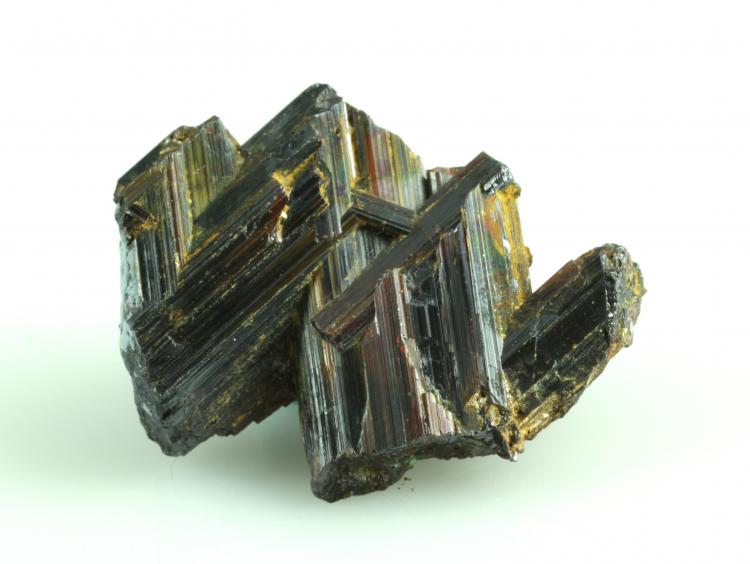
|
|
|
| Back to top |
|
 |
Pete Richards
Site Admin

Joined: 29 Dec 2008
Posts: 828
Location: Northeast Ohio



|
 Posted: Sep 23, 2012 19:46 Post subject: Re: About cyclic twinning - (5) Posted: Sep 23, 2012 19:46 Post subject: Re: About cyclic twinning - (5) |
|
|
| RutileFox wrote: | (snip)
In general, what are the criteria that distinguish between crystals that are merely intergrown versus ones that are twinned? How does this definition determine whether three or more crystals are repeatedly twinned versus just being intergrown?
Below is another rutile from Diamantina similar to the one Tracy has. I'll ignore for now the one small V-twin stacked on top of two larger V-twins. My question is about the two larger V-twins -- are they simply intergrown (V-V), or are they repeated twins (W)?
Based upon the boundary where they contact each another, it looks like the two larger V twins are simply intergrown, but not repeatedly twinned. I'd like some help sorting this out. Thanks.
Peter Farquhar
Claremont, California
USA |
Well..............
First, twinned crystals should always make the same angles with each other for a given twinning relationship. What does "same" mean? Ideally, within a few tenths of a degree or better. And they should be seen over and over again, much more frequently than one could expect by random interactions by two nearby crystals. And they should have a common origin on the matrix (if we can tell what it was). And they should be roughly the same size, and meet each other along a pretty clean joint.
Exceptions to at least some of these guidelines can be found among true twins, but they are indeed exceptions. Probably twins formed in metamorphic environments (staurolite, for example) will follow some of these guidelines somewhat less rigorously than other twins, because of the stresses involved in their formation and subsequent growth.
Third point: Yes, I would agree that there seem to be two separate twins here - V V vs W.
Second point: This specimen brings a new piece into the discussion, because the V's on your twin are steep (about 60° between the two limbs) rather than shallow (about 120°). This is, I suspect, a different twin law - twinning on (301) rather than twinning on (101). I have wonderful single isolated V's from Diamantina with the same shape, as well as examples from other places, and this twin law is well recognized in the literature. You seem to have two intergrown (301) twins. I have no idea how this happened, but it is hard to believe it is a random occurrence. One could create an epitactic model for this as well, but I'm not sure I'm ready to go there!
Now, the angle between the two limbs of a true (301) twin is, theoretically, a bit less than 55°, whereas the angle between a "perverse" epitactic relationship is 60°. You could try to measure the angle and see if you can confidently decide which of these theoretical angles you specimen corresponds to.... And if it's a relic from an epitactic relationship, the join between the two individuals has no reason to be nice and clean.
I'm embarrassed to find that I don't have any digital photos of my lovely Diamantina (301) twins. I'll try to remedy that in a subsequent post....
------
A few moments later, looking at Peter's image again, I'm less confident that the (301) twinning model is correct versus the epitactic model, though (301) twinning is well established. The overall aggregate has a strong motif of prisms at about 120° in three directions, though the left and right "twins" each make 60° angles. But the contact surfaces between these two are apparently not planar, and they are not of the same (though similar) size. And the little crystals that Peter asked us to ignore may actually signal that the basic aggregation model is based on 60 and 120° angles (epitaxy?) and not on angles between twin relationships for rutile.
No, I don't fully understand it yet! I've only been chewing on rutile twinning for 30 years!
_________________
Collecting and studying crystals with interesting habits, twinning, and epitaxy |
|
| Back to top |
|
 |
Peter Farquhar
Site Admin

Joined: 14 May 2011
Posts: 51
Location: Virginia



|
 Posted: Sep 24, 2012 17:21 Post subject: Re: About cyclic twinning - (5) Posted: Sep 24, 2012 17:21 Post subject: Re: About cyclic twinning - (5) |
|
|
Pete, thanks for your help analyzing this latest rutile crystal. As Tracy says, "Puzzles make me happy."
Here are the answers to the questions you raised earlier about the angles of the twins in the last photo of the rutile from Diamantina, Brazil.
| Pete Richards wrote: |
Now, the angle between the two limbs of a true (301) twin is, theoretically, a bit less than 55°, whereas the angle between a "perverse" epitactic relationship is 60°. You could try to measure the angle and see if you can confidently decide which of these theoretical angles you specimen corresponds to.... And if it's a relic from an epitactic relationship, the join between the two individuals has no reason to be nice and clean. |
I measured the angles between the large V twin on the left, the large V twin on the right, and the join between the two twins -- all of them are the same and a little less than 55 degrees as you predicted. The small V twin on top has an angle of about 60 degrees.
I hope this information is helpful.
Peter Farquhar
Claremont, California
USA
|
|
| Back to top |
|
 |
Duncan Miller

Joined: 25 Apr 2009
Posts: 138
Location: South Africa



|
 Posted: Sep 27, 2012 02:07 Post subject: Re: About cyclic twinning - (5) Posted: Sep 27, 2012 02:07 Post subject: Re: About cyclic twinning - (5) |
|
|
Consider a concise definition of 'cyclic twinning' as given in a basic textbook like Dana's Manual of Mineralogy (18th edition ed. Hurlbut). "Repeated or multiple twins are made up of three or more parts twinned according to the same law. If all the successive composition surfaces are parallel, the resulting group is a polysynthetic twin. If successive composition planes are not parallel, a cyclic twin results."
Now, if in the latter case the twinning proceeds in the same direction each time, either right or left, an open U or a closed loop cyclic twin forms. If the twinning alternates, with the same angular relationship between individuals but orientated alternately right and left, a zigzig shape will result. Here the composition planes appear to be parallel, so in terms of the above definition these would be polysynthetic twins.
If one accepts this simple, purely geometric definition then interesting crystal growth issues like penetration twins vs cyclic twins and single nucleation vs successive nucleation perhaps do not determine whether a particular twinned crystal should be described as cyclic. It simply depends on whether successive composition planes are parallel or not. Isn't cyclic twinning just a special case of polysynthetic twinning? (Please note, I cautiously wrote 'perhaps' here because I am also trying to clarify things myself. I am no expert on twinning.)
Duncan
|
|
| Back to top |
|
 |
Pete Richards
Site Admin

Joined: 29 Dec 2008
Posts: 828
Location: Northeast Ohio



|
 Posted: Sep 27, 2012 08:34 Post subject: Re: About cyclic twinning - (5) Posted: Sep 27, 2012 08:34 Post subject: Re: About cyclic twinning - (5) |
|
|
| xenolithos wrote: | (snip)
If one accepts this simple, purely geometric definition then interesting crystal growth issues like penetration twins vs cyclic twins and single nucleation vs successive nucleation perhaps do not determine whether a particular twinned crystal should be described as cyclic. It simply depends on whether successive composition planes are parallel or not. Isn't cyclic twinning just a special case of polysynthetic twinning? (Please note, I cautiously wrote 'perhaps' here because I am also trying to clarify things myself. I am no expert on twinning.)
Duncan |
I think it is true that the question of what to call it (cyclic, polysynthetic, repeated, etc) is separate from the question of how it grew. I think you probably meant to ask if cyclic twinning isn't just a special case of "repeated or multiple twinning" rather than a special case of polysynthetic twinning - to be consistent with your quote from Dana.
I would say that in my experience the term "polysynthetic twinning" is most commonly applied to minerals that are twinned many, many times - the prime example being plagioclase feldspars - not just several times, as in some of the rutile we have been discussing.
_________________
Collecting and studying crystals with interesting habits, twinning, and epitaxy |
|
| Back to top |
|
 |
Duncan Miller

Joined: 25 Apr 2009
Posts: 138
Location: South Africa



|
 Posted: Sep 27, 2012 09:43 Post subject: Re: About cyclic twinning - (5) Posted: Sep 27, 2012 09:43 Post subject: Re: About cyclic twinning - (5) |
|
|
Pete thanks for your response.
Perhaps I confused two points.
1. I was thinking about the zigzig twins shown above. Are the composition planes not parallel? They are repeated or multiple twins, but according to the Dana definition they would seem to be polysynthetic twins, despite not being repeated very numerous times as in plagioclase feldspars. I know we tend to think of polysynthetic twinning as characteristically having large numbers of lamellar twins, but isn't this just a matter of number, not geometry?
2. If repeat 'geniculate' twin are polysynthetic (in Dana's sense) then don't cyclical twins differ only in having a consistent twinning handedness? I understand that polysynthetic and cyclical twinning generally are seen as distinct categories of repeat twinning but perhaps they just differ in handedness of the geniculation. I will attached a scanned image from the Dana volume of rutile twins to illustrate what I mean.
On a somewhat different tack, from reading the earlier discussion it appears that genetically there may be two kinds of cyclical twinning, both conforming to Dana's geometric definition. The classic chrysoberyl and aragonite sixling twins may be penetration twins, making them distinct from the 'hollow' wheel cyclic twins of rutile, which have repeated 'geniculation' in the same orientation. Is this not a more fundamental distinction than the diverse rutile examples?
Duncan
| Description: |
|
| Viewed: |
34780 Time(s) |
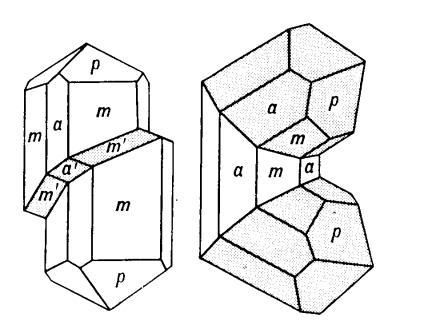
|
|
|
| Back to top |
|
 |
Pete Richards
Site Admin

Joined: 29 Dec 2008
Posts: 828
Location: Northeast Ohio



|
 Posted: Sep 27, 2012 12:03 Post subject: Re: About cyclic twinning - (5) Posted: Sep 27, 2012 12:03 Post subject: Re: About cyclic twinning - (5) |
|
|
| xenolithos wrote: | Pete thanks for your response.
Perhaps I confused two points.
1. I was thinking about the zigzig twins shown above. Are the composition planes not parallel? They are repeated or multiple twins, but according to the Dana definition they would seem to be polysynthetic twins, despite not being repeated very numerous times as in plagioclase feldspars. I know we tend to think of polysynthetic twinning as characteristically having large numbers of lamellar twins, but isn't this just a matter of number, not geometry?
2. If repeat 'geniculate' twin are polysynthetic (in Dana's sense) then don't cyclical twins differ only in having a consistent twinning handedness? I understand that polysynthetic and cyclical twinning generally are seen as distinct categories of repeat twinning but perhaps they just differ in handedness of the geniculation. I will attached a scanned image from the Dana volume of rutile twins to illustrate what I mean.
On a somewhat different tack, from reading the earlier discussion it appears that genetically there may be two kinds of cyclical twinning, both conforming to Dana's geometric definition. The classic chrysoberyl and aragonite sixling twins may be penetration twins, making them distinct from the 'hollow' wheel cyclic twins of rutile, which have repeated 'geniculation' in the same orientation. Is this not a more fundamental distinction than the diverse rutile examples?
Duncan |
Let me start by saying that the following are my OPINIONS (perhaps not sufficiently humble). They are backed up by my experience, but not always by a text book that I can refer you to....
1. The twin planes are indeed parallel. However, Dana's Textbook (Fourth edition, 1932, W.E. Ford author, article 246) only uses the term "polysynthetic" explicitly to refer to feldspars, though he also refers to it as parallel repetition and uses the term polysynthetic in the title of the artlcle. In the case of these rutile twins, I think it is not necessary to hone the description beyond "repeated twins" - not necessary to decide whether to call them polysynthetic or cyclic. Because the term "polysynthetic" has such a connotation of abundantly repeated, lamellar morphology, I would not use it to describe the zig-zag rutile twins. In my mineral catalog, my several examples are described as "repeated" or "zig-zag". I never thought to describe them as polysynthetic.
2. As indicated in my response to 1, I think applying the term polysynthetic to rutile is a misreading of Dana. Be that as it may, the difference between the zig-zag twins and cyclic twins is one of parallelism or lack of it of adjacent twin planes. It can be thought of as a question of handedness, I guess, though handedness has another meaning for crystals that lack a center of symmetry, like quartz. The planes of twinning are basically the same crystallographically, but their orientation to each other makes all the difference in the morphology of the twin.
On your final point, chrysoberyl and aragonite are generally described as penetration twins, while some others (my example is marcasite) cannot be, because there are only five individuals. If chrysoberyl and aragonite are truly penetration twins, they have only three individuals and thus are really trillings. But I think reality is more complex. Perhaps someone did a study of aragonite and determined optically that there were only three independent orientations, or perhaps someone just thought about it and decided that is the way it is. Once that model got published, it became the "truth". I am starting a study of aragonite to see if I can verify or refute the penetration model by study of thin sections. I expect to find that the distinction between the penetration and contact models is an idealization of what actually occurs, and would not be surprised to find some examples with very complex, "wormy" intergrowths instead of the nice planar contacts we imagine are always there!
As for the hollow "wheel twins", I think they are a figment of an old morphological crystallographer's imagination. Ford's article 245 describes "metagenetic" twinning as the way this happens, and explicitly says that the (c-shaped) crystal grew as a single crystal to "a length of a half inch or more", then simultaneously budded off new growth on both ends in twinned orientation, (which then continued to grow). He refers to this as geniculation. I believe this whole model is totally wrong and totally inconsistent with what we know of how crystals grow - it is the thinking of someone in 1932, or more likely 1898, when the first edition of the Textbook was copyrighted! I have never seen a hollow cyclic twin, though certainly ones with "dimples" in the middle are common. My several examples of eightlings of rutile from Magnet Cove have deep dimples that suggest holes, but they are solid at depth - somewhat analogous in shape to hopper-shaped crystals of vanadinite or pyromorphite. The same appears to be true of several examples that have been posted to this thread.
_________________
Collecting and studying crystals with interesting habits, twinning, and epitaxy |
|
| Back to top |
|
 |
Pete Richards
Site Admin

Joined: 29 Dec 2008
Posts: 828
Location: Northeast Ohio



|
 Posted: Sep 27, 2012 12:33 Post subject: Re: About cyclic twinning - (5) Posted: Sep 27, 2012 12:33 Post subject: Re: About cyclic twinning - (5) |
|
|
I mentioned rutile twinned on {301} some while back in this thread, but did not have an image. I just scanned a slide I had of one of mine - no it's not really cyclic twinning, but it sure is pretty....
| Description: |
Rutile
Diamantina, Minas Gerais, Brazil
1 cm tall
|
|
| Viewed: |
35143 Time(s) |
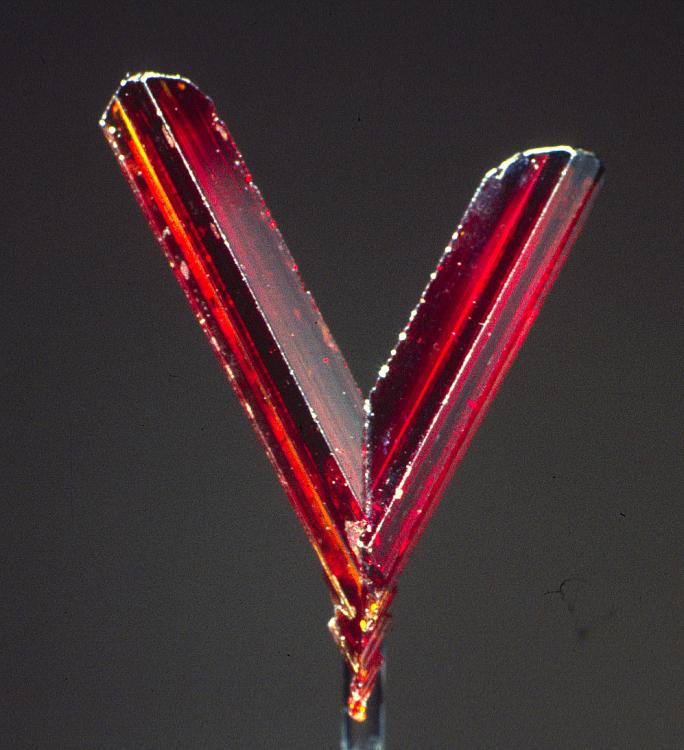
|
_________________
Collecting and studying crystals with interesting habits, twinning, and epitaxy |
|
| Back to top |
|
 |
Duncan Miller

Joined: 25 Apr 2009
Posts: 138
Location: South Africa



|
 Posted: Sep 28, 2012 02:14 Post subject: Re: About cyclic twinning - (5) Posted: Sep 28, 2012 02:14 Post subject: Re: About cyclic twinning - (5) |
|
|
| Pete Richards wrote: | | The planes of twinning are basically the same crystallographically, but their orientation to each other makes all the difference in the morphology of the twin. |
Pete, once again thanks for your thoughtful response. The above quote puts very nicely what I was trying to say, in my roundabout way. I look forward to seeing the outcome of your study of the sixling/trilling issue. It's a nice project. If you are not familiar with it already, may I recommend you look at Schmetzer, K & Malsy, A-K. 2011. Alexandrite and colour-change chrysoberyl from the Lake Manyara alexandrite-emerald deposit in northern Tanzania. Journal of Gemmology 32:179-209. It contains numerous illustrations and photographs in transmitted light of what they describe as 'trilling' twins, with a very clear illustration of the hypothesised growth sequence. Duncan
|
|
| Back to top |
|
 |
Elise

Joined: 22 Dec 2009
Posts: 243
Location: New York State



|
|
| Back to top |
|
 |
|



